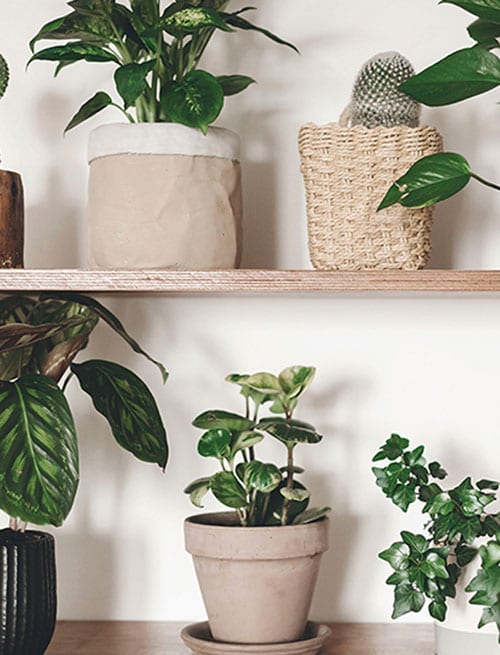Today’s Trendiest Houseplants
WRITTEN BY CATRIONA TUDOR ERLER
Houseplants have always been an integral part of interior design. Their live element lends depth, cleans the air, and provides natural color. As with all facets of interior design, styles trend and plants do too. Read on to find out which plants you’ve been seeing in home decor and how to make them your own.
SANSEVIERIA (SANSEVIERIA TRIFASCIATA)
The delightfully evocative common names—snake plant, devil’s tongue, viper’s bowstring hemp (the fibers were used for bow strings), and mother-in-law’s tongue—are not what make Sansevieria a hit on the houseplant trending charts. People love its structural, vertical form (it can grow as tall as twelve feet) and range of colors. In addition to the green variety (dark- and pale-green markings enliven the foliage), Laurentii has cream colored leaves with dark-green, horizontal patterns.
Tough as nails Sansevieria thrives in difficult situations, including low light, dry air, and neglect. Put it in bright light if you can, water it once or twice a month, dust off the leaves once or twice a year, and don’t worry about misting—the plant loves dry air. As a bonus, NASA has identified Sansevieria as one of the top air purifying plants, capable of removing at least 107 pollutants. It is a great warrior against “sick building syndrome.”
CROCODILE FERN (MICROSORIUM MUSIFOLIUM ‘CROCYDYLLUS’)
Be gone boring Boston ferns. The latest trend in indoor ferns is the wrinkled, puckered crocodile fern. Despite the textured appearance resembling crocodile skin, the large, glossy, pale-green leaves with dark veining are ruffled, giving the plant a delicate and graceful appearance. At maturity, the plants are two to five feet tall and wide. Water when soil feels dry and feed with diluted water-soluble all-purpose fertilizer or fern fertilizer once a month during spring and summer.
Crocodile fern will grow in bright or low light, but it needs humidity. Either mist regularly or set it on a tray filled with gravel and water. It is susceptible to fern scale. If you notice flaky, white spots on the foliage or stems, apply insecticide oil to the affected leaves. (The high humidity that makes these ferns thrive also encourages fungus growth.) To avoid fern scale, trim off crowded fronds to encourage airflow and don’t overwater. If you still have a problem, fungicide foliar sprays and soil drenches can help.
DRAGON TREE (DRACAENA MARGINATA)
Named for the half-dragon, half-woman of Greek mythology, dragon trees bring an electric energy to a room. The spiky leaves spring from the plant’s stems like hair standing on end. There are several hybrids available: ‘Bicolor’ has pale-green leaves enlivened with clean pink edges; ‘Pink Tricolor’ has bright-pink foliage with white-and-green stripes; ‘Ray of Sunshine’ has bold yellow-and-cream stripes up the center of the green leaves.
Dracaena will survive in dim light, although it grows best in bright, indirect light. When moved from low light to a brighter spot, the new leaves will be stronger and the growth rate will increase. In the wild, this species will grow up to fifteen feet tall; however, you can control the size by lopping off stems when they grow too long. New leaves will sprout from the lopped off spot. Water when the soil feels dry, and feed with liquid foliage fertilizer monthly during spring and summer months.
MEYER LEMON (CITRUS X MEYERII)
The glossy-leafed, Improved Meyer Lemon makes a handsome houseplant. Its blossoms fill the air with a sweet, gardenia-like aroma and, if the tree gets enough light, it will bear fruit.
Begin by potting up your lemon, increasing the pot size from two gallons for a small plant up to fifteen gallons for a mature specimen. Use an acidic potting soil such as a peat moss mix or potting soil designed for cacti.
A south-facing window is preferred for the ideal eight to twelve hours of direct sunlight. If you can’t provide much natural light, set up grow lights and leave them on for twelve hours a day. To maintain humidity, place the pot on a pebble- and water-filled saucer. Mist with water when the soil feels nearly dry (typically weekly), and fertilize with NPK fertilizer every three to six weeks depending on the season. The lemon trees can withstand temperatures as low as 20 degrees F, so move them outside during the summer when they can soak in as much sunlight as possible.

